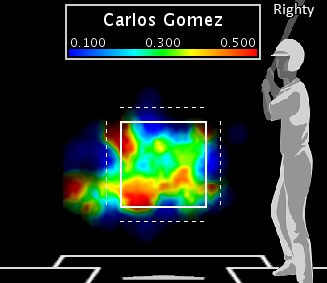Carlos Gomez Uses Opposite Field, Develops into Elite Hitter
 Alec Dopp |
Alec Dopp |  Monday, December 16, 2013 at 12:44PM
Monday, December 16, 2013 at 12:44PM
Arguably the biggest storyline in an otherwise forgettable 2013 campaign for the Milwaukee Brewers was the development of center fielder Carlos Gomez, whose career-best 8.4 bWAR last season was the second highest mark of any position player in baseball -- beating out the likes of NL MVP Andrew McCutchen (8.2 bWAR) and AL MVP Miguel Cabrera (7.2 bWAR). Missing just five of 162 regular season games, the former Mets top prospect posted career-highs in batting average (.284), OPS (.843), weighted on-base average (.344) and walk rate (6.3%), along with setting personal bests in defensive WAR (4.6) and stolen bases (40).
Of course, one of Gomez's career-best marks set last season that pundits remain skeptical of was his .344 batting average on balls in play (BABIP, for short), which increased dramatically from his 2012 mark of .296. The reason behind his success last season, many said, mainly stemmed from the increase in BABIP -- a stat that measures a player's batting average, excluding strikeouts and home runs. Some went as far as to say Gomez was one of the "luckiest" hitters in baseball last season. While I acquiesce that there is at least some luck involved with maintaining a high BABIP, I tend to think that hitters maketheir own luck by augmenting specific facets of their approach at the plate.
Such is the case with Gomez last season.
Gomez's BA on hits located to center and right field, 2012

Gomez's BA on hits located to center and right field, 2013
 A pull hitter if there ever was one, Gomez relied heavily on his ability to yank pitches to left field with authority in posting a .413 batting average in such situations two seasons ago. Consequently, he struggled to maintain such a high mark on hits to center and right field, garnering a .275 average on such hits and ranking in the bottom 25% of the league in that respect. And as we can see from the first image, there was no specific area of the zone where Gomez's center and opposite field-hits originated from. Instead, it lacked any noticeable consistency.
A pull hitter if there ever was one, Gomez relied heavily on his ability to yank pitches to left field with authority in posting a .413 batting average in such situations two seasons ago. Consequently, he struggled to maintain such a high mark on hits to center and right field, garnering a .275 average on such hits and ranking in the bottom 25% of the league in that respect. And as we can see from the first image, there was no specific area of the zone where Gomez's center and opposite field-hits originated from. Instead, it lacked any noticeable consistency.
That all changed last season, where Gomez clearly made it a point to go either the opposite way or to center field with pitches located on the outer half of the plate. As such, he posted a much-improved .359 batting average on opposite and center-field hits -- placing himself just outside the top fourth of all qualified batters. Another reason for Gomez's success hitting to center and right field? He place better quality contact behind those hits, posting a .197 well-hit average last season compared to his .152 mark in 2012.
But how does BABIP tie into all this? Last season, hits located to either center field or the batter's pull side generated a BABIP of .304, compared to the .312 league average BABIP on hits located to either center field or the batter's opposite field. What this means is that hitters are more likely to maintain a higher BABIP on hits located to their opposite field than to the pull side, which minimize's the "luck" factor placed upon Gomez last season, since his increases were so significant. But since Gomez placed significantly better contact on such pitches last season, I tend to think he made his own luck.
